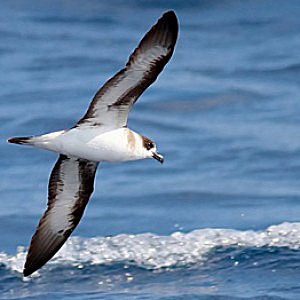
The first Black-capped Petrels were fitted with solar-powered telemetry packages to learn about their movements and nesting locations (photo by Alfred Yan).
|
A milestone study is beginning to de-mystify the movements a rare species of seabird – the elusive Black-capped Petrels that are found off the coast of North Carolina along the Gulf Stream, but nest on Hispaniola, the Caribbean island shared by the Dominican Republic and Haiti far to the south. During an initial eight-month study, Black-capped Petrels were caught and fitted with solar-powered satellite transmitters, then tracked through the nesting season.
Extreme habitat loss at their nesting areas was thought to have driven the species extinct until its rediscovery in 1963. Black-capped Petrels remain in danger as a species, with less than 1,000 pairs known today. To learn more about the species, last May the American Bird Conservancy (ABC) and its partners launched this ambitious project.
A key part of the project was tracking white morph Black-capped Petrels, which some biologists have suggested are a separate species, to their nesting sites. All 83 Black-capped Petrel nests found up to that point belonged to dark morph petrels.
As tracking progressed, most of the petrels with transmitters remained in the northwest Atlantic, but the team tracked two Black-capped Petrels – one light morph and one dark morph – to Hispaniola where their movements indicated they were nesting.
While the researchers hoped the white morph petrel might lead them to a new nesting island, such as Dominica or Cuba, they now have the first evidence of a potential nesting location for the white morph Black-capped Petrel, and have confirmed that they arrive four to six weeks earlier than dark morph petrels.
“In addition to helping us answer the nesting riddle, these data are valuable in our understanding of habitat use off the East Coast,” explained Brad Keitt, ABC’s Oceans & Islands Program Director. “They also can help us to anticipate potential impacts of future energy development, such as offshore windpower, to the Black-capped Petrel, a species currently being considered for listing as Threatened under the Endangered Species Act.”
The tracking study helped fill important data gaps identified in the Conservation Action Plan for the Black-capped Petrel, which was updated in 2019 by the American Bird Conservancy and others under the umbrella of the International Black-capped Petrel Conservation Group. This updated plan builds on 10 years of work on the species since the first plan was written, and has created a roadmap for targeted actions in the future.
These actions include protecting existing nests and known nesting areas in Haiti and the Dominican Republic from invasive species and habitat loss; finding new nests, new colonies, and new nesting islands; creating new nesting colonies through translocation to predator-free fenced enclosures or to new nesting islands; and reducing adult mortality from collisions with communications towers and other threats at known nesting colonies.
“The results showing a white morph petrel is likely nesting in the Dominican Republic and that they are possibly nesting four to six weeks earlier than the dark morph birds are important, both for our understanding of the Black-capped Petrel and to help us prioritize conservation actions,” said Keitt. “It is clear that we need to continue searching for nests in Hispaniola and to determine if white morph petrels have nest sites that are discrete or overlapping with dark morph birds.” The next steps are to finalize the goals identified in the Conservation Action Plan and to begin implementing them.
The project was led by ABC’s Brad Keitt, and included Patrick Jodice (with the US Geological Survey) and Yvan Satge (at Clemson University) with the South Carolina Cooperative Fish and Wildlife Research Unit; Chris Gaskin; and Brian Patteson and Kate Sutherland at Seabirding Pelagic Trips out of Hatteras, North Carolina.
ABC works with partners to protect and minimize threats at nesting areas for Black-capped Petrels and continues to urge the United States to sign on to the international Agreement on the Conservation of Albatrosses and Petrels, that coordinates activities that benefit these seabirds. For more information about this article, see https://abcbirds.org/article/milestone-black-capped-petrel-tracking-results and for more information about Seabirding Pelagic Trips, see http://www.patteson.com/